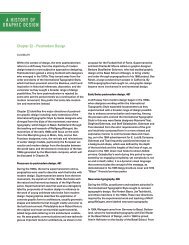Week 9 Graphic Design and the Industrial Revolution - A History of ...
Week 9 Graphic Design and the Industrial Revolution - A History of ...
Week 9 Graphic Design and the Industrial Revolution - A History of ...
- No tags were found...
Create successful ePaper yourself
Turn your PDF publications into a flip-book with our unique Google optimized e-Paper software.
A HISTORY OFGRAPHIC DESIGNJohn Gamble, page 152, was granted a patent in 1801 for “an invention for making paper in single sheets without seamor joining from one to twelve feet <strong>and</strong> upwards wide, <strong>and</strong> from one to forty-five feet <strong>and</strong> upwards in length.” This machinepoured a suspension <strong>of</strong> fiber <strong>and</strong> water in a thin stream upon a vibrating wire-mesh conveyor belt on which anunending sheet <strong>of</strong> paper could be manufactured.Ottmar Mergenthaler (1854–1899), page 152, a German immigrant working in a Baltimore machine shop who achieved<strong>the</strong> first patent for a type composing machine in 1825 called <strong>the</strong> Linotype machine. On July 3, 1886, <strong>the</strong> thirty-two-yearoldinventor demonstrated his keyboard-operated machine in <strong>the</strong> <strong>of</strong>fice <strong>of</strong> <strong>the</strong> New York Tribune. Whitelaw Reid, <strong>the</strong>editor <strong>of</strong> <strong>the</strong> Tribune, reportedly exclaimed, “Ottmar, you’ve done it! A line o’ type.” The new machine received its namefrom this enthusiastic reaction (Fig. 9-23).Tolbert Lanston (1844–1913), page 153, <strong>the</strong> American who, in 1887, invented <strong>the</strong> Monotype machine, which cast singlecharacters from hot metal.Joseph Niépce (1765–1833), page 153, a Frenchman who first produced a photographic image. He began his research byseeking an automatic means <strong>of</strong> transferring drawings onto printing plates. He invented <strong>the</strong> heliogravure (sun engraving),<strong>and</strong> exp<strong>and</strong>ed his discovery by putting one <strong>of</strong> his pewter plates in <strong>the</strong> back <strong>of</strong> his camera obscura <strong>and</strong> pointingit out <strong>the</strong> window. This allowed him to make a picture directly from nature; <strong>the</strong> earliest extant photograph is a pewtersheet that he exposed all day (Figs. 9-26 <strong>and</strong> 9-27).Louis Jacques Daguerre (1799–1851), page 154, worked with Joseph Niépce <strong>and</strong> perfected <strong>the</strong> early photographic process,which he presented to <strong>the</strong> French Academy <strong>of</strong> Sciences. He called <strong>the</strong> printed images he created daguerreotypes(Fig. 9-28).William Henry Fox Talbot (1800–1877), page 154, pioneered a process that formed <strong>the</strong> basis for both photography <strong>and</strong>photographic printing plates by working with objects held over paper treated with silver compounds <strong>and</strong> exposed tolight. He called <strong>the</strong>se images, made without a camera, “photogenic drawings.” He began to use his treated paper in <strong>the</strong>camera obscura to create minute photographic images that had light areas rendered dark <strong>and</strong> dark areas appearinglight. Late in 1840 he managed to increase <strong>the</strong> light sensitivity <strong>of</strong> his paper, expose a latent image, <strong>the</strong>n develop it afterit was removed from <strong>the</strong> camera. He called his new process “calotype” (from <strong>the</strong> Greek kalos typos, meaning “beautifulimpression”) <strong>and</strong> also used <strong>the</strong> name “talbotype” at <strong>the</strong> suggestion <strong>of</strong> friends. In 1844 he began publishing his book,The Pencil <strong>of</strong> Nature, in installments for subscribers, featuring twenty-four photographs mounted into each copy byh<strong>and</strong> (Figs. 9-29 <strong>and</strong> 9-32; see also 9-47).Sir John Herschel (1792–1871), page 155, an eminent astronomer <strong>and</strong> chemist who was <strong>the</strong> first to use sodium thiosulfateto fix, or make permanent, <strong>the</strong> photographic image on paper by halting <strong>the</strong> action <strong>of</strong> light. He was also <strong>the</strong> first toname <strong>the</strong> process <strong>of</strong> photography (from <strong>the</strong> Greek photos graphos, meaning “light drawing”); <strong>the</strong> reversed image <strong>of</strong> aphotograph a “negative”; <strong>and</strong> <strong>the</strong> contact a “positive” (Figs. 9-30 <strong>and</strong> 9-31).Frederick Archer (1813–1857), page 155, an English sculptor who was <strong>the</strong> first to announce <strong>the</strong> wet-plate process in <strong>the</strong>March 1850 issue <strong>of</strong> Chemist. By c<strong>and</strong>lelight in a darkroom, a clear viscous liquid called collodion was sensitized withiodine compounds, poured over a glass plate, immersed in a silver-nitrate bath, <strong>and</strong> exposed <strong>and</strong> developed in <strong>the</strong>camera while still wet. It enabled much shorter exposure times than ei<strong>the</strong>r daguerreotypes or calotypes, <strong>and</strong> almostcompletely replaced <strong>the</strong>m by <strong>the</strong> mid-1850s.George Eastman (1854–1932), page 157, an American dry-plate manufacturer who put <strong>the</strong> power <strong>of</strong> photography into<strong>the</strong> h<strong>and</strong>s <strong>of</strong> <strong>the</strong> lay public when he introduced his Kodak camera in 1888 (Fig. 9-33).John Calvin Moss, page 157, pioneered a commercially feasible photoengraving method for translating line artwork intometal letterpress plates in 1871. In a highly secret process, a negative <strong>of</strong> <strong>the</strong> original art was contact printed to a metalplate coated with a light-sensitive gelatin emulsion, <strong>the</strong>n etched with acid. The gradual implementation <strong>of</strong> photoengravingcut <strong>the</strong> cost <strong>and</strong> time required to produce printing blocks <strong>and</strong> achieved greater fidelity to <strong>the</strong> original (Fig. 9-34).Stephen H. Horgan, page 158, invented <strong>the</strong> halftone screen (Figs. 9-37 <strong>and</strong> 9-38).Frederick E. Ives (1856–1937), page 158, developed an early halftone process <strong>and</strong> worked on <strong>the</strong> first commercial pro-
















